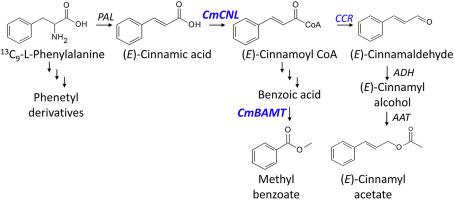当前位置:
X-MOL 学术
›
Phytochemistry
›
论文详情
Our official English website, www.x-mol.net, welcomes your feedback! (Note: you will need to create a separate account there.)
Differential metabolism of L–phenylalanine in the formation of aromatic volatiles in melon ( Cucumis melo L.) fruit
Phytochemistry ( IF 3.8 ) Pub Date : 2018-04-01 , DOI: 10.1016/j.phytochem.2017.12.018 Itay Gonda , Rachel Davidovich-Rikanati , Einat Bar , Shery Lev , Pliaa Jhirad , Yuval Meshulam , Guy Wissotsky , Vitaly Portnoy , Joseph Burger , Arthur A. Schaffer , Yaakov Tadmor , James J. Giovannoni , Zhangjun Fei , Aaron Fait , Nurit Katzir , Efraim Lewinsohn
Phytochemistry ( IF 3.8 ) Pub Date : 2018-04-01 , DOI: 10.1016/j.phytochem.2017.12.018 Itay Gonda , Rachel Davidovich-Rikanati , Einat Bar , Shery Lev , Pliaa Jhirad , Yuval Meshulam , Guy Wissotsky , Vitaly Portnoy , Joseph Burger , Arthur A. Schaffer , Yaakov Tadmor , James J. Giovannoni , Zhangjun Fei , Aaron Fait , Nurit Katzir , Efraim Lewinsohn

|
Studies on the active pathways and the genes involved in the biosynthesis of L-phenylalanine-derived volatiles in fleshy fruits are sparse. Melon fruit rinds converted stable-isotope labeled L-phe into more than 20 volatiles. Phenylpropanes, phenylpropenes and benzenoids are apparently produced via the well-known phenylpropanoid pathway involving phenylalanine ammonia lyase (PAL) and being (E)-cinnamic acid a key intermediate. Phenethyl derivatives seemed to be derived from L-phe via a separate biosynthetic route not involving (E)-cinnamic acid and PAL. To explore for a biosynthetic route to (E)-cinnamaldehyde in melon rinds, soluble protein cell-free extracts were assayed with (E)-cinnamic acid, CoA, ATP, NADPH and MgSO4, producing (E)-cinnamaldehyde in vitro. In this context, we characterized CmCNL, a gene encoding for (E)-cinnamic acid:coenzyme A ligase, inferred to be involved in the biosynthesis of (E)-cinnamaldehyde. Additionally we describe CmBAMT, a SABATH gene family member encoding a benzoic acid:S-adenosyl-L-methionine carboxyl methyltransferase having a role in the accumulation of methyl benzoate. Our approach leads to a more comprehensive understanding of L-phe metabolism into aromatic volatiles in melon fruit.
中文翻译:

L-苯丙氨酸在甜瓜(Cucumis melo L.)果实芳香挥发物形成中的差异代谢
关于肉质水果中 L-苯丙氨酸衍生挥发物生物合成的活性途径和基因的研究很少。甜瓜果皮将稳定同位素标记的 L-phe 转化为 20 多种挥发物。苯丙烷、苯丙烯和苯类化合物显然是通过众所周知的苯丙烷类途径产生的,该途径涉及苯丙氨酸解氨酶 (PAL),并且 (E)-肉桂酸是关键中间体。苯乙基衍生物似乎是通过不涉及 (E)-肉桂酸和 PAL 的单独生物合成途径从 L-phe 衍生而来的。为了探索甜瓜皮中 (E)-肉桂醛的生物合成途径,使用 (E)-肉桂酸、CoA、ATP、NADPH 和 MgSO4 检测可溶性蛋白无细胞提取物,在体外产生 (E)-肉桂醛。在这种情况下,我们表征了 CmCNL,一种编码 (E)-肉桂酸的基因:辅酶 A 连接酶,推测参与 (E)-肉桂醛的生物合成。此外,我们描述了 CmBAMT,一种 SABATH 基因家族成员,编码苯甲酸:S-腺苷-L-甲硫氨酸羧基甲基转移酶,在苯甲酸甲酯的积累中起作用。我们的方法有助于更全面地了解 L-phe 代谢成甜瓜果实中芳香挥发物的过程。
更新日期:2018-04-01
中文翻译:

L-苯丙氨酸在甜瓜(Cucumis melo L.)果实芳香挥发物形成中的差异代谢
关于肉质水果中 L-苯丙氨酸衍生挥发物生物合成的活性途径和基因的研究很少。甜瓜果皮将稳定同位素标记的 L-phe 转化为 20 多种挥发物。苯丙烷、苯丙烯和苯类化合物显然是通过众所周知的苯丙烷类途径产生的,该途径涉及苯丙氨酸解氨酶 (PAL),并且 (E)-肉桂酸是关键中间体。苯乙基衍生物似乎是通过不涉及 (E)-肉桂酸和 PAL 的单独生物合成途径从 L-phe 衍生而来的。为了探索甜瓜皮中 (E)-肉桂醛的生物合成途径,使用 (E)-肉桂酸、CoA、ATP、NADPH 和 MgSO4 检测可溶性蛋白无细胞提取物,在体外产生 (E)-肉桂醛。在这种情况下,我们表征了 CmCNL,一种编码 (E)-肉桂酸的基因:辅酶 A 连接酶,推测参与 (E)-肉桂醛的生物合成。此外,我们描述了 CmBAMT,一种 SABATH 基因家族成员,编码苯甲酸:S-腺苷-L-甲硫氨酸羧基甲基转移酶,在苯甲酸甲酯的积累中起作用。我们的方法有助于更全面地了解 L-phe 代谢成甜瓜果实中芳香挥发物的过程。

























 京公网安备 11010802027423号
京公网安备 11010802027423号